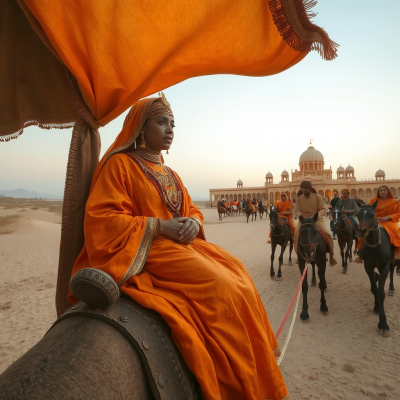Queens and Mothers: Makeda, Queen of Sheba, Aksum (Ethiopia)

Makeda, the Biblical queen of Sheba, journeyed from her country in a region of the African kingdom of Axum to witness the wisdom of King Solomon for herself (Imagined by AI)
The Biblical Entrance: The Queen of Sheba Arrives With Hard Questions
The world was first introduced to the Queen of Sheba in the Bible, specifically in 1 Kings 10. Around 946 BC, a mysterious, wealthy queen journeyed to Jerusalem, drawn by stories of King Solomon’s divine wisdom. She came not as a visitor, but as a peer, arriving with an extravagant caravan laden with gold, spices, precious stones, and most importantly, deep questions.
Scripture tells us she “came to test him with hard questions.” The queen’s intent wasn’t just diplomacy—it was intellectual and spiritual inquiry. She engaged Solomon in profound conversations and was stunned by the depth of his wisdom, the excellence of his palace, and the just nature of his rulings. According to the Bible, she was so overwhelmed that she was left breathless: “there was no more spirit in her.”
Then, she disappears from the biblical narrative as suddenly as she arrived.
Although referred to simply as the “Queen of Sheba” in the Bible, scholars and traditions across Africa and the Middle East offer varying accounts of her identity. Some say she was Makeda, queen of the Kingdom of Saba (or Sheba), which may have been located in what is now Ethiopia or Yemen.
Historians have long debated the queen’s true homeland. However, one of the most enduring and celebrated narratives comes not from the Bible, but from an ancient Ethiopian text: the Kebra Nagast.
The Kebra Nagast: Ethiopia’s National Epic
The Kebra Nagast (“Glory of Kings”) is a 14th-century Ethiopian chronicle that offers an expanded version of the story of the Queen of Sheba. According to this sacred text, she was Queen Makeda of Saba. During her visit to Solomon, the two not only exchanged wisdom but also conceived a child: Menelik I.
Menelik, raised in the Axumite Kingdom, would become the founding patriarch of Ethiopia’s Solomonic dynasty. As the story goes, when Menelik reached adulthood, he traveled to Jerusalem to meet his father. Upon his return, he was accompanied by Jewish nobles—and secretly, the Ark of the Covenant.
According to the Kebra Nagast, the Ark of the Covenant (the sacred chest that housed the stone tablets of the Ten Commandments) was brought to Ethiopia by Menelik and his companions. This claim is echoed by the Ethiopian Orthodox Church, which believes it has been the custodian of the Ark ever since.
Why would Solomon allow the Ark to leave Israel? Ethiopian legend suggests it was God’s will, a response to Solomon’s turning away from Yahweh due to his hundreds of pagan wives, which led him into idolatry. Biblical texts, including 1 Kings 11, support this narrative of Solomon’s apostasy.
If this tale holds any historical truth, it would mean that Ethiopia inherited a sacred spiritual lineage going back to ancient Israel.
The Ethiopian Orthodox Church is one of the oldest Christian institutions in the world. Its origins are traced back to the 4th century, when King Ezana of Axum converted to Christianity.
However, if the Kebra Nagast’s account is valid, Ethiopia’s religious heritage began centuries earlier, rooted in a fusion of Judaism and African spiritual traditions, long before the spread of Christianity.
This connection between Ethiopia and Israel through Queen Makeda and Menelik I adds profound historical and theological weight to Ethiopia’s spiritual culture. It also establishes Ethiopia as a pivotal crossroads between Africa and the Biblical world.
The Enduring Legacy of Queen Makeda
Far from vanishing from history, the Queen of Sheba lives on in legend, art, and the royal identity of Ethiopia.
She is celebrated as a symbol of female wisdom and leadership, the mother of Ethiopia’s royal bloodline, a diplomatic genius and seeker of truth; and as a divine bridge between nations and faiths.
Her story has inspired generations of Ethiopian rulers; Poets, painters, and playwrights across Europe and Africa; and a deep-rooted belief in Ethiopia’s sacred destiny.
Even today, the Church of Our Lady Mary of Zion in Axum is believed to house the Ark of the Covenant. Only one guardian monk is permitted to see it, preserving its mystery and sanctity.
The Queen of Sheba was more than a visitor in Solomon’s court. She was a ruler in her own right, a mother of nations, and a spiritual ancestor to millions. Her story is not just a footnote in someone else’s history; it is a foundation for African legacy and pride.
Through the lens of the Kebra Nagast and the traditions of Ethiopia, we are invited to see her not just as a character in someone else’s book, but as the heroine of an African epic, one that bridges continents, faiths, and generations.
She may have walked out of Solomon’s palace, but she walked into legend.
References:
-
The Bible (1 Kings 10, 2 Chronicles 9, 1 Kings 11)
-
The Kebra Nagast (translated by Sir E. A. Wallis Budge)
-
Hubbard, David Allan. The Rediscovery of the Queen of Sheba
-
Ethiopian Orthodox Tewahedo Church archives
-
Visual Commentary on Scripture (www.thevcs.org)
You can read more here. Learn about more African Queens and More.
